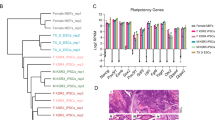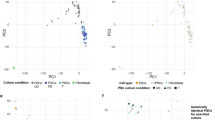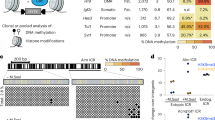Abstract
It remains controversial whether the abnormal epigenetic modifications accumulated in the induced pluripotent stem cells (iPSCs) can ultimately affect iPSC pluripotency. To probe this question, iPSC lines with the same genetic background and proviral integration sites were established, and the pluripotency state of each iPSC line was characterized using tetraploid (4N) complementation assay. Subsequently, gene expression and global epigenetic modifications of “4N-ON” and the corresponding “4N-OFF” iPSC lines were compared through deep sequencing analyses of mRNA expression, small RNA profile, histone modifications (H3K27me3, H3K4me3, and H3K4me2), and DNA methylation. We found that methylation of an imprinted gene, Zrsr1, was consistently disrupted in the iPSC lines with reduced pluripotency. Furthermore, the disrupted methylation could not be rescued by improving culture conditions or subcloning of iPSCs. Moreover, the relationship between hypomethylation of Zrsr1 and pluripotency state of iPSCs was further validated in independent iPSC lines derived from other reprogramming systems.
Similar content being viewed by others
Log in or create a free account to read this content
Gain free access to this article, as well as selected content from this journal and more on nature.com
or
References
Takahashi K, Yamanaka S . Induction of pluripotent stem cells from mouse embryonic and adult fibroblast cultures by defined factors. Cell 2006; 126:663–676.
Chin MH, Mason MJ, Xie W, et al. Induced pluripotent stem cells and embryonic stem cells are distinguished by gene expression signatures. Cell Stem Cell 2009; 5:111–123.
Doi A, Park IH, Wen B, et al. Differential methylation of tissue- and cancer-specific CpG island shores distinguishes human induced pluripotent stem cells, embryonic stem cells and fibroblasts. Nat Genet 2009; 41:1350–1353.
Guenther MG, Frampton GM, Soldner F, et al. Chromatin structure and gene expression programs of human embryonic and induced pluripotent stem cells. Cell Stem Cell 2010; 7:249–257.
Kim K, Doi A, Wen B, et al. Epigenetic memory in induced pluripotent stem cells. Nature 2010; 467:285–290.
Polo JM, Liu S, Figueroa ME, et al. Cell type of origin influences the molecular and functional properties of mouse induced pluripotent stem cells. Nat Biotechnol 2010; 28:848–855.
Stadtfeld M, Apostolou E, Akutsu H, et al. Aberrant silencing of imprinted genes on chromosome 12qF1 in mouse induced pluripotent stem cells. Nature 2010; 465:175–181.
Carey BW, Markoulaki S, Hanna JH, et al. Reprogramming factor stoichiometry influences the epigenetic state and biological properties of induced pluripotent stem cells. Cell Stem Cell 2011; 9:588–598.
Jiang J, Lv W, Ye X, et al. Zscan4 promotes genomic stability during reprogramming and dramatically improves the quality of iPS cells as demonstrated by tetraploid complementation. Cell Res 2013; 23:92–106.
Zhao XY, Li W, Lv Z, et al. iPS cells produce viable mice through tetraploid complementation. Nature 2009; 461:86–90.
Bock C, Kiskinis E, Verstappen G, et al. Reference maps of human ES and iPS cell variation enable high-throughput characterization of pluripotent cell lines. Cell 2011; 144:439–452.
Kang L, Wang J, Zhang Y, Kou Z, Gao S . iPS cells can support full-term development of tetraploid blastocyst-complemented embryos. Cell Stem Cell 2009; 5:135–138.
Kou Z, Kang L, Yuan Y, et al. Mice cloned from induced pluripotent stem cells (iPSCs). Biol Reprod 2010; 83:238–243.
Maston GA, Evans SK, Green MR . Transcriptional regulatory elements in the human genome. Annu Rev Genomics Hum Genet 2006; 7:29–59.
Hikichi T, Kohda T, Wakayama S, Ishino F, Wakayama T . Nuclear transfer alters the DNA methylation status of specific genes in fertilized and parthenogenetically activated mouse embryonic stem cells. Stem Cells 2008; 26:783–788.
Wang Y, Joh K, Masuko S, et al. The mouse Murr1 gene is imprinted in the adult brain, presumably due to transcriptional interference by the antisense-oriented U2af1-rs1 gene. Mol Cell Biol 2004; 24:270–279.
Lin SP, Youngson N, Takada S, et al. Asymmetric regulation of imprinting on the maternal and paternal chromosomes at the Dlk1-Gtl2 imprinted cluster on mouse chromosome 12. Nat Genet 2003; 35:97–102.
Stadtfeld M, Apostolou E, Ferrari F, et al. Ascorbic acid prevents loss of Dlk1-Dio3 imprinting and facilitates generation of all-iPS cell mice from terminally differentiated B cells. Nat Genet 2012; 44:398–405, S391–S392.
Bird A . DNA methylation patterns and epigenetic memory. Genes Dev 2002; 16:6–21.
Reik W, Dean W, Walter J . Epigenetic reprogramming in mammalian development. Science 2001; 293:1089–1093.
Hiura H, Toyoda M, Okae H, et al. Stability of genomic imprinting in human induced pluripotent stem cells. BMC Genet 2013; 14:32.
Jiang H, Sun B, Wang W, et al. Activation of paternally expressed imprinted genes in newly derived germline-competent mouse parthenogenetic embryonic stem cell lines. Cell Res 2007; 17:792–803.
Li C, Chen Z, Liu Z, et al. Correlation of expression and methylation of imprinted genes with pluripotency of parthenogenetic embryonic stem cells. Hum Mol Genet 2009; 18:2177–2187.
Hatada I, Sugama T, Mukai T . A new imprinted gene cloned by a methylation-sensitive genome scanning method. Nucleic Acids Res 1993; 21:5577–5582.
Nabetani A, Hatada I, Morisaki H, Oshimura M, Mukai T . Mouse U2af1-rs1 is a neomorphic imprinted gene. Mol Cell Biol 1997; 17:789–798.
Zhang Z, Joh K, Yatsuki H, et al. Comparative analyses of genomic imprinting and CpG island-methylation in mouse Murr1 and human MURR1 loci revealed a putative imprinting control region in mice. Gene 2006; 366:77–86.
Ficz G, Hore TA, Santos F, et al. FGF signaling inhibition in ESCs drives rapid genome-wide demethylation to the epigenetic ground state of pluripotency. Cell Stem Cell 2013; 13:351–359.
Esteban MA, Wang T, Qin B, et al. Vitamin C enhances the generation of mouse and human induced pluripotent stem cells. Cell Stem Cell 2010; 6:71–79.
Huangfu D, Osafune K, Maehr R, et al. Induction of pluripotent stem cells from primary human fibroblasts with only Oct4 and Sox2. Nat Biotechnol 2008; 26:1269–1275.
Marks H, Kalkan T, Menafra R, et al. The transcriptional and epigenomic foundations of ground state pluripotency. Cell 2012; 149:590–604.
Xie W, Barr CL, Kim A, et al. Base-resolution analyses of sequence and parent-of-origin dependent DNA methylation in the mouse genome. Cell 2012; 148:816–831.
Wang J, Fan HC, Behr B, Quake SR . Genome-wide single-cell analysis of recombination activity and de novo mutation rates in human sperm. Cell 2012; 150:402–412.
Bernstein BE, Mikkelsen TS, Xie X, et al. A bivalent chromatin structure marks key developmental genes in embryonic stem cells. Cell 2006; 125:315–326.
Chang G, Miao YL, Zhang Y, et al. Linking incomplete reprogramming to the improved pluripotency of murine embryonal carcinoma cell-derived pluripotent stem cells. PloS One 2010; 5:e10320.
Langmead B, Trapnell C, Pop M, Salzberg SL . Ultrafast and memory-efficient alignment of short DNA sequences to the human genome. Genome Biol 2009; 10:R25.
Zhang Y, Liu T, Meyer CA, et al. Model-based analysis of ChIP-Seq (MACS). Genome Biol 2008; 9:R137.
Kidder BL, Hu G, Zhao K . ChIP-Seq: technical considerations for obtaining high-quality data. Nat Immunol 2011; 12:918–922.
Xu H, Handoko L, Wei X, et al. A signal-noise model for significance analysis of ChIP-seq with negative control. Bioinformatics 2010; 26:1199–1204.
Trapnell C, Pachter L, Salzberg SL . TopHat: discovering splice junctions with RNA-Seq. Bioinformatics 2009; 25:1105–1111.
Roberts A, Pimentel H, Trapnell C, Pachter L . Identification of novel transcripts in annotated genomes using RNA-Seq. Bioinformatics 2011; 27:2325–2329.
Robinson MD, McCarthy DJ, Smyth GK . edgeR: a bioconductor package for differential expression analysis of digital gene expression data. Bioinformatics 2010; 26:139–140.
Acknowledgements
We thank our colleague Dr Bing Zhu for his critical comments on the manuscript. We thank Prof Rudolf Jaenisch (the Whitehead Institute of MIT) for generously supplying the lentivirus vectors. We are also grateful to our laboratory colleagues for their assistance with experiments and preparation of the manuscript. This work was supported by the Ministry of Science and Technology (2011CB812700, 2010CB944900, and 2011CB964800 to SG, 2011AA100303 and 2011BAD19B01 to JT, 2011ZX09102-010-04 to TC) and the National Natural Science Foundation of China (31000656 to GC).
Author information
Authors and Affiliations
Corresponding authors
Additional information
( Supplementary information is linked to the online version of the paper on the Cell Research website.)
Supplementary information
Supplementary information, Figure S1
The pluripotency evaluation of iPCCs used in high-throughput sequencing and reads coverage plots at the transcription start site ± 2KB regions. (PDF 308 kb)
Supplementary information, Figure S2
The validation of some cell-line specific transcripts in high-throughput sequencing iPSCs using quantitative PCR. (PDF 371 kb)
Supplementary information, Figure S3
The DNA methylation, gene expression of Zrsr1, Murr1, and Dlk1-Dio3 gene cluster. (PDF 440 kb)
Supplementary information, Figure S4
DNA methylation state of Zrsr1 in Vc-iPSCs. (PDF 81 kb)
Supplementary information, Table S1
Summary of the iPSC lines used (PDF 97 kb)
Supplementary information, Table S2
The evaluation of high-throughput sequencing datasets (XLS 60 kb)
Supplementary information, Table S3
Summary of cell line-specific deviations in HT iPSCs (PDF 11 kb)
Supplementary information, Table S4
The top ten candidate loci between “4N-ON” and “4N-OFF” iPSCs (XLS 50 kb)
Supplementary information, Table S5
The reads distribution of MeDIP-Seq at the well-known DMRs (XLS 56 kb)
Rights and permissions
About this article
Cite this article
Chang, G., Gao, S., Hou, X. et al. High-throughput sequencing reveals the disruption of methylation of imprinted gene in induced pluripotent stem cells. Cell Res 24, 293–306 (2014). https://doi.org/10.1038/cr.2013.173
Received:
Revised:
Accepted:
Published:
Issue date:
DOI: https://doi.org/10.1038/cr.2013.173
Keywords
This article is cited by
-
BrewerIX enables allelic expression analysis of imprinted and X-linked genes from bulk and single-cell transcriptomes
Communications Biology (2022)
-
Conserved regulation of RNA processing in somatic cell reprogramming
BMC Genomics (2019)
-
Culture of haploid blastocysts in FGF4 favors the derivation of epiblast stem cells with a primed epigenetic and transcriptional landscape
Scientific Reports (2018)
-
Embryonic germ cell extracts erase imprinted genes and improve the efficiency of induced pluripotent stem cells
Scientific Reports (2018)
-
Integrated analysis of hematopoietic differentiation outcomes and molecular characterization reveals unbiased differentiation capacity and minor transcriptional memory in HPC/HSC-iPSCs
Stem Cell Research & Therapy (2017)



